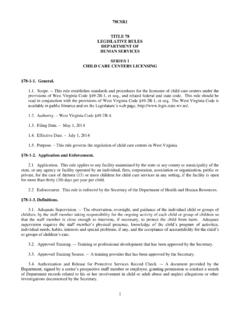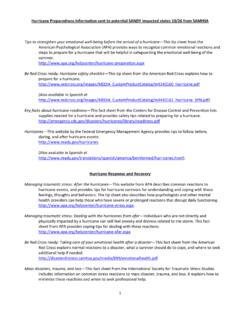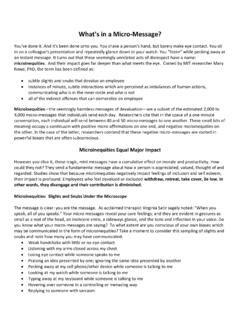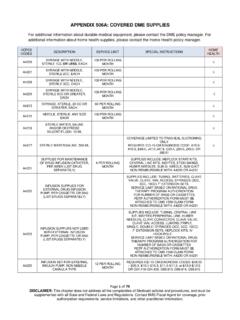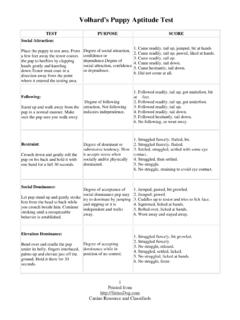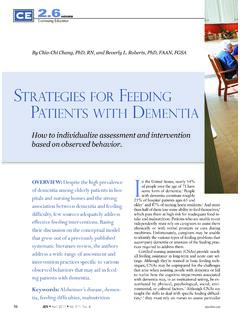Transcription of Interpersonal Therapy (IPT)
1 Interpersonal Psychotherapy (IPT). John C. Linton, PhD, ABPP. Professor and Vice Chair Department of Behavioral Medicine WVU School of Medicine, Charleston WV. IPT Introduction the last three years have been like one endless workday without rest for me. Now it's over my poor mother doesn't need me nor the boys either.. How free you must feel! . No, only unspeakably empty. Nothing to live for now.. Henrik Ibsen A Doll's House IPT Introduction Interpersonal Relations and Mood Attachment theory: proposed by J. Bowlby, suggests that humans have an innate tendency to seek attachments, that these attachments contribute to the survival of the species, and to individual satisfaction.
2 Attachments lead to reciprocal, personal, social bonds with significant others, and to experiences of warmth, nurturance and protection. They also decrease vigilance and muscle tone. These attachments intense human emotions. IPT Introduction Humans are vulnerable to depression if attachments do not develop early They are also vulnerable to depression if attachment bonds are disrupted Humans of all ages are most happy, effective and competent when they are confident that one or more trusted persons are available for help in time of trouble So Therapy should combine caring with non-possessive warmth, and should provide, as part of the IPT relationship, a cognitive explanation of distortions in past relationships.
3 IPT Introduction Adult Experiences and Depression Stressful life events: within six months of a stressful life event, the onset of depression risk increases Exits of persons from the individual's life in the preceding six months occurs more frequently in depressed than non-depressed patients IPT Introduction Social Support Care eliciting behavior is essential in attachment bonding. This is a pattern of activity from one person that elicits from another responses which give comfort, both physical [touch, hugs] and verbal [encouragement]. Repertoire is small and focused in childhood, but matures and expands with age This is a means to maintain strong social bonds among members of a group IPT Introduction Intimacy This is an important component of care-eliciting and supportive emotional relations The presence of an intimate and confiding relationship with a significant other can exert a protection against the development of depression in the face of life stress Actual or threatened disruption of this attachment through disputes, separation or divorce is one of the most common and serious disruptions of attachment in adulthood.
4 Often related to the occurrence of depression IPT Introduction Intimacy Marital arguments are the single most frequently reported stressors in the lives of women during the six months preceding treatment for depression We must of course consider the reciprocal effect of depression and marital strain Women with ongoing partner disputes are at higher risk to relapse after the successful treatment of depression IPT Introduction Intimacy If the disputes are resolved, they have the same success rate as women with no marital problems The tendency for depressed women with marital disputes to continue living in discord with the same partner for years underscores the importance of dealing with marital problems in treating depression Interpersonal Therapy (IPT).
5 Long standing interest in shortening psychotherapy by: Increasing the activity of the therapist Narrowing the focus to specific themes Short term Therapy is usually considered from one to 20 sessions Most change occurs in the early sessions IPT. In 1984 NIMH consensus development sessions reflected the state of the field, and identified three techniques proven to work: behavior Therapy Cognitive Therapy IPT. Cognitive and behavior are now CBT. IPT. What sets IPT apart is that it is brief, proactive, and its single focus is Interpersonal roles and relationships It was developed in the 1970s by Gerald Klerman, who asked social workers what techniques they used to treat depression, especially how depressive sx were categorized IPT.
6 IPT is based on the theory of Swiss psychiatrist Adolph Meyer, who was an international graduate, and had to study under Johns Hopkins psychiatrist Harry Stack Sullivan. IPT is founded on the hypothesis that the crucial factor in depression is the social network of the patient IPT. Specifically, it holds that depression is caused by: a. disturbed social roles b. unsatisfactory Interpersonal relationships c. and they have an interaction effect . IPT. Disturbed relationships, especially absence or loss of significant others at all ages can be risk factors for depressive disorders The depression disturbs Interpersonal relations, leading to more depression This is like Social Darwinism, one fails to adapt to one's surroundings Disturbed Relationships More Depression Depression More Relationship Disturbance IPT.
7 The goal is to reverse this process, and the Washington School decided to focus on Interpersonal relations, rather than intrapsychic processes The unit of observation was not the larger culture or the person, but rather the primary social group, the immediate face to face interactions one has with others IPT. So the unit of study became relations the patient has with significant others, family and love relationships, friendships, work and community. Based on early science such as mother-infant attachments, failure of which can lead to depression Also findings that close personal bonds can protect against depression in those who are biologically vulnerable, and reverse depression more easily in those already depressed.
8 British research shows in depressed women there is often an exit from the social field in previous six months IPT. Where IPT fits on the Continuum Analytic CBT Interpersonal Social/Community Some differences make a difference. One Therapy is not right for all patients IPT is designed for outpatient, non-psychotic, unipolar depressed adolescents, adults and elderly, regardless of the non-medical etiology of the depression Designed to be used with medications IPT. Goals: 1. Reduce symptoms of depression 2. Bring major changes in the patient's close Interpersonal relations, and develop new strategies to deal with significant others. Sometimes run sessions for families of those who are depressed to educate them 3.
9 Prevent recurrence of depression IPT. Again, the fundamental concept is roles. For example, depression in boys girls is equal until early adolescence, when roles begin to be defined, and depression increases in females. Then add to the role menstruation, childbirth and menopause Note increased depression since WW II, perhaps due to failure to achieve the high standards we set for ourselves, and the role expectations that accompany them. Women: Sex Objects Men: Success Objects IPT. Gender Role Strain How should a man be and behave? How should a woman be and behave? How does gender role strain differ from men to women? IPT. Development of Depression 1. Symptoms such as sleep and appetite changes 2.
10 Change in Interpersonal relations 3. Character structure may predispose to depression IPT intervenes with 1 and 2, can't with 3. IPT. Treatment First Stage: Sessions 1,2,3. First session is reconnaissance, fly over the terrain to see what is there, then return to fill in the blanks. Important to cover medical causes, review past episodes, assess lethality. Then shift to communication analysis: who said what, to whom, and what was the effect? Be specific. The next two sessions hone in on what was found in the first. IPT. Focus is on here and now Therapist is active, using directive and nondirective techniques, and offers: information {most are clueless about psychiatric conditions}.




